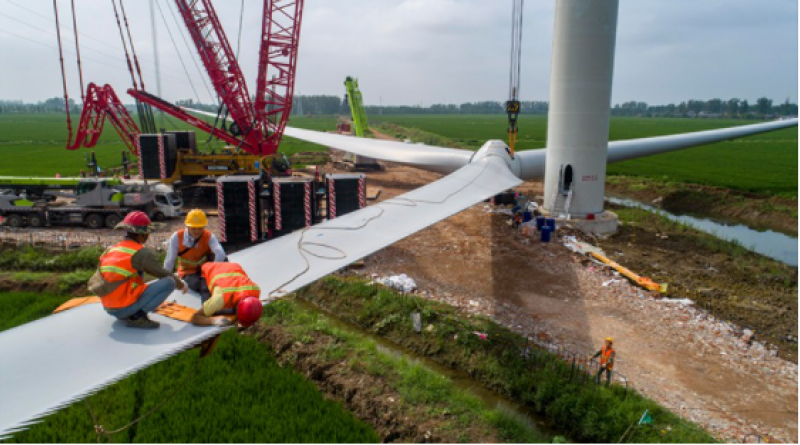China creates vast research infrastructure to support ambitious climate goals

Carbon-neutrality institutes, and other initiatives to support a pledge to achieve net zero by 2060, are popping up like mushrooms across China.
China, the world’s top carbon emitter, has for the first time published plans broadly outlining how it might achieve net-zero carbon emissions by 2060, and a peak of emissions before 2030 — promises it made in 2019.
Researchers say the documents, released ahead of the COP26 climate talks that concluded on 15 November, send a strong message to industry, government agencies and universities in China to ramp up their efforts to help the country meet its climate goals.
Already this year, more than ten prominent universities and institutions have set up carbon-neutrality-research institutes; the Chinese Academy of Sciences launched a centre last month.
“We start right now,” says Jiang Kejun, a modeller at the Energy Research Institute in Beijing.
The country is experiencing a “national movement”, says Wu Libo, an environmental economist at Fudan University in Shanghai, as companies, regional governments and academia shift gears.
Wu is also director of the Shanghai Research Institute for Energy and Carbon Neutrality Strategy, a collaboration launched earlier this month by the university and the Shanghai city government. Once it secures funding for research grants, the institute will focus on the deregulation of the electricity market and climate finance, she says.
Significant challenge
Achieving carbon neutrality by 2060 “is a big challenge for China”, says Xie Xiaomin, an energy-policy researcher at Shanghai Jiao Tong University (SJTU). She is vice-director of the university’s Research Institute of Carbon Neutrality, which was established in May and has already received about 20 million yuan (US$3.1 million) in funding to work on a broad range of energy technologies, she says.
From emitting more than 11 gigatonnes of carbon dioxide in 2020, China has to drop to net zero within four decades. This is a scale and speed that no other country has attempted before, says Gang He, an energy-systems modeller at Stony Brook University in New York, who has studied China’s power system.
China’s current emissions are more than double the United States’ and three times as big as those of India, which made a similar pledge to reach net zero by 2070 during COP26.
“There will be a lot of areas needing contribution from researchers,” says Fu Sha, a modeller with the non-profit Energy Foundation China in Beijing. These include low-carbon energy technologies, from hydrogen fuel cells to batteries; market-based mechanisms to control emissions, such as carbon taxes and trading schemes; and modelling that will help local governments and industries set realistic targets for cuts, she says.
Researchers will also need to study which sections of China’s population will be most affected by the transition and learn how to help them cope, says He. Establishing the path to “a more just and inclusive transition would be a very important research topic”, he says.

Solar, wind and hydro
But many research institutes have a long way to go in terms of aligning their research departments with the carbon-neutrality goals, says Jiang. They will need to drop traditional engineering subjects that focus, for example, on coal-fired boiler technology and internal combustion engines, notes Zhang Xiliang, a climate modeller at Tsinghua University in Beijing, which launched its own Institute for Carbon Neutrality in September.
The two highly anticipated policy documents the central government released in October — a working guidance and a 2030 action plan — outline a path for researchers and flesh out for the first time how China plans to achieve its carbon goals.
The documents talk about “strengthening basic research and research on cutting-edge technologies” — such as nuclear fusion, smart grids and new materials — and the formulation of “an action plan to ensure science and technology better support” achieving carbon neutrality.
Also detailed in the documents are commitments to increase the share of power China produces from renewable and nuclear sources from just 16% today to 80% by 2060. Solar and wind capacity are planned to reach 1,200 gigawatts by 2030 — enough to power hundreds of millions of households — and 80 gigawatts of hydropower will be installed over the next decade.
Carbon capture and sequestration technologies will also be important to achieving China’s goals, according to the documents, and could be another focus for researchers. There is also a plan for electric and hybrid vehicles to make up 40% of those sold by 2030. Much more detail is expected to come in future documents, say researchers.
Global ramifications
Despite this rush of activity towards net zero within China, some researchers are still disappointed with the commitments the country has made so far.
At the COP26 meeting, the nation signed a joint declaration with the United States to find steeper cuts, but frustrated some scientists by not offering more-aggressive pledges for the next decade, and also for pushing for text concerning coal in the final agreement to be edited from ‘phased out’ to ‘phased down’.
China’s promises so far are not likely to keep global warming to below 1.5 °C — the more aspirational of the targets set by world governments at the United Nations Paris climate meeting in 2015 — says Yan Qin, an economist and carbon analyst based in Oslo with Refinitiv, a company that provides data on financial markets. “What has been pledged falls short,” she says.
China has also not yet set any absolute limits on emissions, nor targets for emissions of other greenhouse gases besides carbon, such as methane, but has committed to doing both. Researchers say these measures will be crucial for the world to have a chance at limiting global warming to below 1.5 °C.
China’s size means its pledges have global ramifications, says Pep Canadell, chief research scientist at the Australian government’s CSIRO Climate Science Centre in Canberra. “When China moves a little to the left or the right, up or down, the whole world feels it.”
And He says that although China’s goals are not as ambitious as some would like, they are at least realistic. “What China should do is sometimes not what China can deliver,” he says.
doi: https://doi.org/10.1038/d41586-021-03491-6
22 November 2021
Nature





